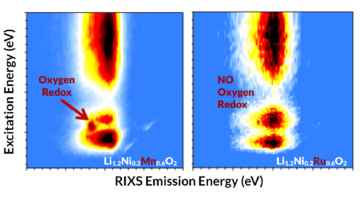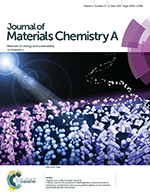Researchers isolated human-derived antibodies that protect against malaria, and protein-structure studies revealed the antibodies’ site of attack. The discovery paves the way for the development of a more effective and practical human vaccine for malaria, which is responsible for half a million deaths every year. Read more »![]()
![]()
Experimental Evidence of Chiral Ferrimagnetism in Amorphous GdCo Films
Harnessing high‐resolution Lorentz microscopy, Robert Streubel and co‐workers visualize chiral ferrimagnetic domain walls in amorphous films, revealing a composition dependence that potentially enables a temperature control of intrinsic domain wall properties. The reconstructed electron phase (magnetic induction) of achiral Bloch domain walls is shown here. Read more »
Reversible Fe(II) uptake/release by magnetite nanoparticles
The coexistence of magnetite and aqueous Fe2+ is common in anoxic subsurface environments and can have a great influence on important biogeochemical redox processes. This study demonstrates that the flow direction of electron equivalents in the form of Fe(II) across the magnetite–solution interface changes in a predictable fashion by altering solution pH, background Fe2+(aq) concentration, and magnetite loading. Read more »
New Clues to Oxygen’s Role in Higher-Capacity Batteries
As battery electrodes, layered transition-metal (TM) oxides demonstrate storage capacities far beyond what’s explained solely by TM redox activity. In this work, measurements of the lattice oxygen redox activity in two lithium-rich layered oxides showed strong oxygen redox when manganese was the TM, but not with ruthenium. Read more »
3D Localization of Nanoscale Battery Reactions
A new tool lets researchers pinpoint the locations of chemical reactions happening inside batteries in three dimensions at the nanoscale level. Combining ptychography, tomography, and spectroscopy, Nanosurveyor 1 is a multidimensional tool providing novel insight into the design of next-generation batteries and devices. Read more »
A facile route for the synthesis of heterogeneous crystal structures in hierarchical architectures with vacancy-driven defects via the oriented attachment growth mechanism
TiO2 nanorod arrays based on substrates with heterogeneous crystal structures and remarkable crystalline stability have potential as promising photocatalysts. Researchers synthesized a 1D anatase/rutile heterogeneous TiO2 crystal structure in a hierarchical architecture by forming hybrid organic–inorganic interfaces in a solution-based environment. Read more »
Molecular Anvils Trigger Chemical Reactions
“Molecular anvils” (diamondoids) were used to trigger chemical reactions using pressure, yielding products that differ from those produced in conventionally driven reactions with the same reactants. The discovery opens up new possibilities for the high-specificity synthesis of valuable but challenging molecules in an environmentally friendly process. Read more »![]()
![]()
The Electronic Structure of a “Kagome” Material
Scientists have verified exotic electronic properties predicted to emerge in a ferromagnetic material with “kagome” (trihexagonal) lattice symmetry. The greater understanding of kagome materials afforded by this work helps open up a new path toward goals such as ultralow-power electronic devices and quantum computing. Read more »![]()
![]()
From Moon Rocks to Space Dust: Berkeley Lab’s Extraterrestrial Research
Berkeley Lab has a well-storied expertise in exploring samples of extraterrestrial origin. This research—which has helped us to understand the makeup and origins of objects within and beyond our solar system—stems from long-standing core capabilities in structural and chemical analyses and measurement at the microscale and nanoscale. Read more »
Experiments at Berkeley Lab Help Trace Interstellar Dust Back to Solar System’s Formation
Experiments conducted at the Department of Energy’s Lawrence Berkeley National Laboratory (Berkeley Lab) helped to confirm that samples of interplanetary particles—collected from Earth’s upper atmosphere and believed to originate from comets—contain dust left over from the initial formation of the solar system. Read more »
- « Previous Page
- 1
- …
- 59
- 60
- 61
- 62
- 63
- …
- 83
- Next Page »









